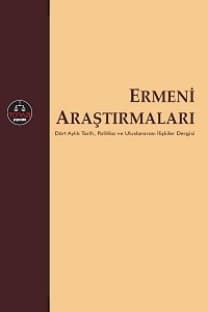1836 TARİHLİ ERMENİ KİLİSESİ NİZAMNAMESİ ÇERÇEVESİNDE ÇARLIK RUSYASI’NIN ERMENİ POLİTİKALARI
Çarlık Rusyası, 1836 yılında yürürlüğe koyduğu bir nizamname ileErmeni kilisesi üzerinde yeni bir idari teşkilat oluşturmuştu. Böylece enbüyük Ermeni dini merkezi olan Eçmiyazin Katoğikosluğu üzerinde ÇarlıkRusyası’nın otoritesi artırılıyordu. Kilisenin devlet kontrolüne alındığı vekatoğikos seçiminde son sözün Rus Çarı’na verildiği bu kanun, Ermenikilisesinin faaliyetlerini ciddi şekilde sınırlıyordu. Rus Çarı ve KafkasyaOrdusu Başkumandanı, katoğikosluk ve bizzat katoğikosun faaliyetleriüzerinde doğrudan etkili hale getiriliyorlardı. Aynı zamanda Rusya gerekligördüğü hallerde katoğikosluğun tüm resmi evrakları ve malları üzerindede söz sahibi olacaktı. Rusya bu siyasetiyle kilisenin yetkilerini daralttığıgibi katoğikosluk üzerinden tüm Ermenileri doğrudan kendine bağlı halegetirmeyi hedefliyordu. Bu durum da Rusya ve Ermeniler arasındakiilişkilerin ilerleyen dönemlerde oldukça olumsuz bir seyir takip etmesinesebebiyet verecekti. Bu çalışmada, Rusya’da yayınlanan bu nizamnameçerçevesinde Rusya’nın Ermenilerle ilgili uygulamaları ortaya konulmaya çalışılacaktır
Anahtar Kelimeler:
Rusya, Osmanlı Devleti, Kafkasya, Eçmiyazin Katoğikosluğu, Taşnaksutyun
(ARMENIAN POLICY OF TSARIST RUSSIA IN THE FRAMEWORK OF 1836 ARMENIAN CHURCH REGULATION)
Tsarist Russia created a new administrative organization on theArmenian Church by a regulation that had put place in 1836. Theregulation, were to increase the power of the Russian authorities over theEtchmiadzin Catholicosate, the largest Armenian religious center. Theregulation limited the Armenian Church’s activities severely by putting thechurch under state control and giving the the Russian Tsar authority overthe Catholicosate elections. This arrangement had given Russian Tsar andthe Caucasus Governor General a definite power on the Catholicosate and its activities. Meanwhile, Russia would have a say in on all official documents and assets of Catholicosate when needed. By the agency of this policy Russia restricted the authority of the church and intended to bind all Armenians directly to the government itself. This would give rather a negative trend in the future relations between Russia and the Armenians. This paper, aims to shed light on the Russian administration of Armenians in the framework of the 1836 regulation.
Keywords:
Russia, Ottoman State, Caucasia, Etchmiadzin Catholicosate, Dashnaktsutiun,
- ISSN: 1303-068X
- Yayın Aralığı: Yılda 2 Sayı
- Başlangıç: 2001
- Yayıncı: Avrasya İncelemeleri Merkezi
Sayıdaki Diğer Makaleler
AİHM’İN PERİNÇEK KARARI: “SOYKIRIM İNKÂRI”/İFADE ÖZGÜRLÜĞÜ İKİLEMİNİN AŞILABİLİRLİĞİ
OSMANLI TAHRİR DEFTERLERİNE GÖRE İRAN-AZERBAYCAN ŞEHİRLERİNDE ERMENİLER
ERMENİ YARDIMSEVER HAYIR CEMİYETİ (ERMENİ CEMİYYET-İ HÂYRİYE-İ UMÛMİYESİ) VE NİZAMNAMESİ
KARABAĞ SORUNUNDA ATEŞKES VE RUSYA
Dağlık Karabağ’ın Ermenistan Sovyet Sosyalist Cumhuriyeti’ne
1836 TARİHLİ ERMENİ KİLİSESİ NİZAMNAMESİ ÇERÇEVESİNDE ÇARLIK RUSYASI’NIN ERMENİ POLİTİKALARI
ERMENİLERİN NAHÇIVAN İDDİALARI VE XX. YÜZYIL BAŞLARINDA YAPILAN KATLİAMLARDA BÜYÜK GÜÇLERİN ROLÜ
